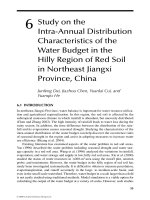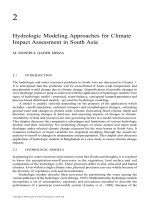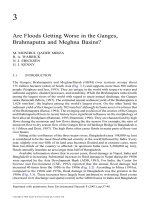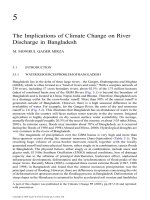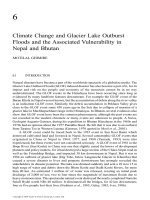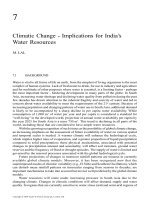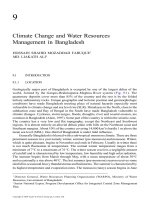Climate Change and Managed Ecosystems - Chapter 6 docx
Bạn đang xem bản rút gọn của tài liệu. Xem và tải ngay bản đầy đủ của tài liệu tại đây (569.36 KB, 21 trang )
127
6
Carbon Dynamics
in Agricultural Soils
R. Lal
CONTENTS
6.1 Introduction 127
6.2 Soil as Moderator of Earth’s Climate 128
6.2.1 Soils and the Global Carbon Cycle 130
6.2.2 Soil Carbon Dynamics 132
6.3 Soil Carbon Sequestration 134
6.3.1 Aggregation 135
6.3.2 Illuviation 136
6.3.3 Secondary Carbonates 136
6.4 Technological Options of Carbon Sequestration in Agricultural Soils 138
6.5 Rates of Soil Carbon Sequestration 139
6.5.1 Measurement Issues Related to Soil Carbon Storage 139
6.6 Conclusions 141
References 141
6.1 INTRODUCTION
Soils are integral component of natural ecosystems. The functioning of ecosystems,
including the cycling of elements and transfer of mass and energy, is moderated
through soils. Yet, the focus of soil science research during the 19th and 20th
centuries has mainly been on two principal soil functions: (1) the medium for plant
(crops, pastures, and trees) growth, and (2) the foundation for civil structures (roads,
buildings, hydraulic dams). The unprecedented growth in human population during
the 20th century led to (1) widespread adoption of the “Green Revolution” technol-
ogies based on intensive management of plant nutrients and available water capacity
of the soil in the effective root zone for enhancing crop yields, (2) rapid expansion
of urban centers, which often necessitated use of fertile topsoil for brick making,
along with development of highways, parking lots, airports, and recreational facil-
ities, and dams to create water reservoirs and hydroelectric generation facilities.
Consequently, the 20th century witnessed rapid advances in soil science with focus
on soil as a medium for plant root growth (e.g., edaphology) with specific reference
to water and nutrient movement through the soil and uptake by plants, elemental
© 2006 by Taylor & Francis Group, LLC
128 Climate Change and Managed Ecosystems
balance, aeration for root/microbial respiration, soil reaction, and optimization of
these properties and processes through anthropic interventions involving tillage or
lack of it, water table management, precision farming, fertigation, etc. Equally
impressive advances were made in soil mechanics and soil hydrology to meet the
requirements for engineering functions of soil.
The human society faces different challenges at the onset of the 21st century.
While there is no cause for complacency in the pursuit of agricultural intensification
for advancing food production to meet the needs of human population growing at
1.3%/annum and expected to reach 8.5 to 9.0 billion by 2050 and eventually stabilize
at the 10 to 11 billion level by 2100. Yet there are other pressing demands on world
soil resources that also require attention. In addition to the two usual functions,
human needs in the 21st century demand prioritization of research on several other
functions of soil. Important among these are (1) repository for industrial, urban, and
nuclear waste, (2) storehouse of germ plasm and biodiversity, (3) archive of human
and planetary history, (4) biomembrane to denature pollutant and purify water, and
(5) moderate the climate. This chapter specifically focuses on the function of soil
as moderator of the climate, through its influence on the global C cycle. World soils
constitute the third largest global C pool comprising 1550 Pg of soil organic carbon
(SOC) and 950 Pg of soil inorganic carbon (SIC). Indeed, the soil C pool of 2500
Pg is 3.3 times the atmospheric pool of 760 Pg and 4.0 times the biotic pool of 620 Pg.
Thus, the objective of this chapter is to illustrate the importance of world soils
in the global carbon (C) cycle. The focus of the discussions is on the interaction
between the soil and the atmospheric C pools under the changing climatic conditions,
with specific reference on C dynamics in agricultural soils because of the need for
their intense management to meet the needs for food, feed, fiber, and fuel production.
6.2 SOIL AS MODERATOR OF EARTH’S CLIMATE
Soil affects and is affected by the climate through numerous interactive processes
(Figure 6.1). Soil affects climate by influencing outgoing (albedo and the long wave
radiation) and incoming (insolation) radiation through its effects on air quality and
the concentration of dust and other particulate materials, and changing amount and
distribution of precipitation through its effect on relative humidity and temperature
under local conditions. In turn, climate strongly affects soil properties
1–3
through its
influences on rate and depth of weathering, intensity and severity of the cycles of
erosion and deposition, quantity and quality of soil C pool and its stratification, and
soil reaction (pH) and the attendant changes in elemental composition and cycling
by flora and fauna (Figure 6.1). Strong interactive processes between soil and climate
have long been recognized by the Dokuchaev School in Russia.
4
The interactions
between soil and the atmosphere (climate) are closely linked to those between soil
and biosphere, soil and lithosphere, and soil and hydrosphere (Figure 6.2). Soil’s
effects on climate are through its influence on the global C cycle. Indeed, the
interactive processes between soil and the environment (e.g., biosphere, hydrosphere,
lithosphere, and the atmosphere) are moderated through changes in soil processes
including the global C cycle. Physical, chemical, and biological processes and
properties are influenced by the climate (Table 6.1). Important soil processes that
© 2006 by Taylor & Francis Group, LLC
Carbon Dynamics in Agricultural Soils 129
FIGURE 6.1 Effects of (A) soil on the atmosphere, (B) atmosphere on soil, and of the interacti
ve processes on the climate.
(A)
(B)
Soil Reaction
Elemental
Concentrations
and Cycling by
Vegetation
Interactive Process
Soil Erosion
and
Sedimentation
Atmosphere
Quantity and
Quality of
Soil C Pools
and
Stratification
Rate and
Depth of
Weathering
and
Horizonation
Precipitation
• Amount
• Distribution
Pedosphere
Air Quality:
Gaseous
concentration
and particulate
matter
Outgoing
and
Incoming
Radiation
Relative
Humidity
© 2006 by Taylor & Francis Group, LLC
130 Climate Change and Managed Ecosystems
are influenced by climate and have strong impact on the soil C cycles are soil
aggregation and erosion, oxidation/mineralization of soil organic matter (SOM), and
methanogenesis. In addition, climate also affects the N cycle through its impact on
nitrification/denitrification processes and emission of N
2
O into the atmosphere. Thus,
natural or anthropogenic change in climate can drastically affect soil properties,
5,6
and the magnitude of change may depend on the antecedent conditions and the
degree of climate change.
6.2.1 S
OILS
AND
THE
G
LOBAL
C
ARBON
C
YCLE
Soils provide numerous ecosystem services of value to humans and functioning of
the biosphere.
7–9
In this regard, the importance of soil in moderating the global C
cycle cannot be overemphasized. Historically, soils have been the source of atmo-
spheric enrichment of CO
2
ever since the dawn of settled agriculture about 10,000
FIGURE 6.2 Interactive processes in soil with its environment with strong influence on the
global C cycle.
Atmosphere
• Concentration
of:
(i) Trace gases
(ii) Particulate
Matter and Soot
Pedosphere
Lithosphere
• Depth
distribution of
soil C
• Organic vs.
inorganic
C Pool
Hydrosphere
• Transport of
dissolved and
suspended C
• Precipitation
of C
Biosphere
• NPP
• Root: Shoot
Ratio
• C:N Ratio
Precipitous
gaseous flux
Particulate
matter
Weathering
elemental
cycling
Leaching
Elemental
cycling
Hypoxia
Erosion
Sedimentation
Biomass
Elemental
cycling
© 2006 by Taylor & Francis Group, LLC
Carbon Dynamics in Agricultural Soils 131
years ago.
10
Most agricultural soils have lost 25 to 75% of their antecedent SOC
pool due to historic land use.
11
The historic loss of SOC pool is estimated at 66 to
90 Pg C, of which the loss due to accelerated erosion by water and wind is 19 to
32 Pg C.
12
Therefore, the SOC pool in most agricultural soils is drastically below
their potential maximum determined by the pedologic and climatic factors. This
deficit in SOC pool, which can be filled through conversion to a restorative land use
and adoption of recommended land use and management practice, is also called the
soil C sink capacity. The C sink capacity of agricultural soils is estimated to be
about 35 to 40 Pg over a 50- to 100-year period.
13,14
Sequestration of 1 Pg of
atmospheric C in soil is equivalent to reduction of atmospheric CO
2
by 0.47 ppm.
Total SOC pool to 1-m depth is 1500 Pg compared to 760 Pg in the atmosphere.
11
TABLE 6.1
Soil Processes and Properties That Are Affected by Climate and That Strongly
Affect the Soil Carbon Pool
Characteristics Soil Processes Soil Properties
I. Physical (a) Structure/aggregation (i) Clay content and mineralogy
(ii) Cementing agents (sesquoxides,
carbonates, organic polymers)
(b) Erosion (i) Soil erodibility
(ii) Rate of new soil formation
(iii) Transportability and sedimentation
(c) Water retention and
transmission
(i) Plant available water capacity
(ii) Least limiting water range
(iii) Infiltration rate
(iv) Deep percolation
(d) Crusting, compaction, and hard
setting
(i) Bulk density
(ii) Porosity and pore size distribution
(iii) Soil strength
II. Chemical (a) Ion exchange (i) Elemental concentration
(ii) Ionic species
(b) Leaching (i) Soil reaction (pH)
(ii) Charge density
(c) Diffusion (i) Concentration gradient
(ii) Tortuosity
III. Biological (a) Oxidation/mineralization (i) Decomposition constant
(ii) C:N ratio and lignin/suberin contents
(b) Soil respiration (i) Soil microbial biodiversity
(ii) Biomass C
(iii) Soil enzymes
(c) Methanogenesis (i) Methanogenic bacteria
(ii) Substrate composition
(d) Nitrification/denitrification (i) Bacterial population
(ii) NO
3
concentration
© 2006 by Taylor & Francis Group, LLC
132 Climate Change and Managed Ecosystems
6.2.2 SOIL CARBON DYNAMICS
The magnitude and rate of depletion of SOC pool depend on land use and soil/plant
management practices (Table 6.2). Practices that lead to severe depletion of SOC
pool include deforestation, conversion of natural to agricultural ecosystems, biomass
burning and residue removal, soil tillage, and extractive or fertility mining practices.
These practices set in motion those processes that exacerbate mineralization of SOM
and increase the rate and cumulative amount of CO
2
-C emission. Attendant changes
in soil properties, with a positive feedback on emission of CO
2
and other greenhouse
gases (GHGs), are reduction in the amount and stability of aggregates, increase in
bulk density with a decrease in available water-holding capacity, and reduction in
hydraulic conductivity and infiltration rate (Table 6.2).
The depletion in SOC pool due to conversion of natural to agricultural ecosystems
and soil cultivation occurs due to (1) reduction in the amount of biomass returned to
the soil, (2) increase in the rate of mineralization usually associated with the change
in soil temperature and moisture regimes, and (3) increase in losses of SOC pool due
to erosion and leaching. In sloping and plowed soils prone to erosion by water and/or
tillage,
15
severe depletion occurs as a consequence of all three processes.
The SOC dynamics in agricultural soils can be described by static and dynamic
models. The static model has been developed and used for five decades.
16–19
It states
that SOC equals gains minus losses of SOC (Equation 6.1).
(6.1)
where C is the SOC pool, K is the decomposition constant, and A is the amount of
C added to the soil through root biomass, crop residue, and other biosolids applied
as amendments, and t is time. At steady state, when the addition of SOC by humi-
fication equals the loss by decomposition (and other processes), dC/dt = 0 and
Equation 6.1 can be rewritten as
C = A/K (6.2)
The decomposition constant K is influenced by practices, processes, and properties
outlined in Table 6.2. Sometimes Equation 6.2 is written in the form
C = hA/K (6.3)
where h is the humification efficiency, which is to 10 to 12% of the annual biomass
addition in temperate climates.
20
In contrast to the static model, the dynamic expo-
nential model is an improvement over the static model.
21–29
The two-component
dynamic model is shown in Equation 6.4.
C
t
= K
1
A/K
2
(l – e
–k
2
t
) + C
O
e
–k
2
t
(6.4)
dC
dt
AKC=−
© 2006 by Taylor & Francis Group, LLC
Carbon Dynamics in Agricultural Soils 133
where C
t
is the SOC pool at time t, C
O
is the antecedent SOC pool at time t = O, K
1
is the annual rate at which biomass is humified and added to the soil and is good for
SOC sequestration, and K
2
is the annual rate of SOC loss by mineralization and erosion,
and K
2
is bad for SOC sequestration. A is the accretion or annual addition of C to the
TABLE 6.2
Land Use and Soil/Plant Management Practices That Exacerbate the
Emission of CO
2
from Soil to the Atmosphere
Practice Processes Affected Properties Altered
A. Deforestation 1. Energy balance (i) Soil temperature
2. Water balance (ii) Soil moisture
3. Compaction (iii) Bulk density
4. Erosion (iv) Porosity
5. Shift in vegetation (v) SOC pool
6. Nutrient cycling (vi) Nutrient reserve
B. Biomass burning 1. Energy balance (i) Soil temperature
2. Water balance (ii) Soil moisture
3. Nutrient balance (iii) Mineralization rate
4. Runoff/leaching (iv) Soil reaction (pH)
5. Net primary productivity (NPP) (v) Hydrophobicity
C. Biomass removal 1. C/elemental cycling (i) SOC pool
2. Crusting/compaction (ii) Nutrient pool
3. Activity of soil fauna (iii) Bulk density
4. Runoff/erosion (iv) Infiltration rate
5. NPP (v) Soil temperature and moisture
regimes
D. Soil tillage 1. Gaseous flux (i) Bulk density
2. Erosion/runoff (ii) Infiltration rate
3. Aggregation (iii) Stability and amount of
aggregation
4. Compaction/crusting (iv) Soil temperature and moisture
regimes
5. Diffusion (v) Permeability
E. Extractive subsistence
farming
1. SOC depletion (i) Soil structure
2. Nutrient depletion (ii) SOC content
3. Elemental cycling (iii) Nutrient reserve
F. Drainage 1. Anaerobiosis (i) Soil moisture and temperature
regimes
2. Methanogenesis (ii) Rate of mineralization
3. Nitrification (iii) Leaching
4. Denitrification (iv) Soil reaction
© 2006 by Taylor & Francis Group, LLC
134 Climate Change and Managed Ecosystems
soil as crop residue or other biosolids. Similar to the static model (Equation 6.1), the
first term [K
1
A/K
2
(1 – e
–k
2
t
)] is an estimate of the addition to the SOC pool through
crop residue, etc., and the second term (C
0
e
–k
2
t
) is an estimate of the decomposition
of C
0
. The difference between the two terms is the net amount of C
t
at any time. Taking
the derivative of Equation 6.4 with respect to t leads to Equation 6.5:
(6.5)
which at equilibrium, when dC/dt = 0, gives Equation 6.6:
C = K
1
A/K
2
(6.6)
Similar to the K in Equation 6.3, K
1
is strongly influenced by the quality of crop residue
(e.g., C:N ratio, lignin and suberin contents). In contrast, K
2
is influenced by soil
properties, climatic factors, and management practices. Good and bad farming/land-
use practices affecting the magnitude of constants K
1
and K
2
are outlined in Table 6.3.
Models described in Equations 6.1 through. 6.6 are based on several assumptions:
30
1. The rate of mineralization depends on the amount of SOC at time t.
2. The rate of mineralization is not limited by lack of other elements (e.g., N).
3. The decomposition constants (K
1
and K
2
) do not change over time.
4. All components of the SOC pool are equally susceptible to mineralization.
The objective of soil and crop management is to maximize C by moderating K
1
, K
2
,
and A through tillage methods, residue management, integrated nutrient manage-
ment, use of compost and biosolids, and cropping systems based on complex rota-
tions and use of cover crops.
6.3 SOIL CARBON SEQUESTRATION
Soil C sequestration implies transfer of a fraction of atmospheric CO
2
into soil C pool
through conversion of pant residue into humus, and retention of humus-C in soil for
a long time. Enhancing the SOC pool of agricultural soils has numerous advantages.
In comparison with engineering techniques (e.g., geologic sequestration, mineraliza-
tion), SOC enhancement is a natural process, has no adverse ecological impacts, is
cost-effective, and improves soil quality. Restoration of soil quality through SOC
enhancement improves biomass/agronomic productivity, improves water quality by
reducing erosion and sedimentation and non-point-source pollution, improves air qual-
ity by reducing wind erosion, and mitigates global warming by reducing the net rate
of enrichment of atmospheric CO
2
. In some cases, however, herbicide effectiveness
may be decreased in soils containing high SOC concentration.
31,32
Several important mechanisms of protection of SOC sequestered in soil include
physical, chemical, and biological processes,
33–38
some of which are described
below.
dC
dt
KA KC=−
12
© 2006 by Taylor & Francis Group, LLC
Carbon Dynamics in Agricultural Soils 135
6.3.1 AGGREGATION
Physical protection of SOC is an important mechanism of increasing the residence
time of C in soil, and it involves its encapsulation within a stable aggregate. Humic
compounds, comprising long-chain polymers, stabilize micro-aggregates against
disruptive forces including chemical, mechanical, and biological processes. Several
models have been proposed suggesting the role of SOC in stabilization of soil
aggregates.
39
The classical model of Edwards and Bremmer
34
illustrates the mechanism of
physical protection of SOC through stabilization of micro-aggregates (Equation 6.7):
Micro-aggregate = [(Cl–P–OM)
x
]
y
(6.7)
where Cl is clay particle, P is polyvalent cation (e.g., Fe
3+,
Al
3+
, Ca
2+
, Mg
2+)
, OM is
organic molecule, and x and y are the number of these units bonded together by
cementing agents to form a secondary particle or a microaggregate. The OM thus
TABLE 6.3
Factors Affecting the Value of Constants K
1
and K
2
Parameters
Factors Increasing the Value of Constants
K
1
Representing Humification
Efficiency (good practices)
K
2
Representing Loss by Erosion
and Mineralization (bad practices)
1. Climate
(i) Rainfall High Low
(ii) Temperature Low High
(iii) Type Temperate, boreal, tundra, taiga Tropics, subtropics
2. Soil
(i) Clay High Low
(ii) Minerology 2:1, high-activity clays 1:1, low-activity clays
(iii) Water retention High Low
(iv) Type Heavy texture, poorly drained Light texture, excessively drained
3. Soil Management
(i) Tillage No-till, conservation tillage Plow tillage
(ii) Residue Surface mulch Incorporation, removal, burning
(iii) Fertility Integrated nutrient management Nutrient deficit, fertility mining
4. Crop Management
(i) Rotations Complex Simple
(ii) Cover crops Winter cover crops Continuous cropping
(iii) Agroforestry With tree-based systems Without tree-based systems
(iv) Farming systems With animal and ley farming Without animal
5. Landscapes
(i) Slope gradient Gentle to none Undulating to steep
(ii) Position Foot slopes Summit and shoulder slopes
(iii) Shape Concave/depositional Convex
(iv) Drainage density Low High
(v) Aspect North facing South facing
© 2006 by Taylor & Francis Group, LLC
136 Climate Change and Managed Ecosystems
sequestered is physically protected against microbial processes and is not mineral-
ized. The strong bonding agents (e.g., polyvalent cations, long-chain organic poly-
mers) stabilize the aggregate while weak bonds (e.g., Na
+
) disperse/slake the aggre-
gate (Equation 6.8).
(6.8)
Dispersion or breakdown of micro-aggregates (such as by raindrop impact or by
the shearing effect of flowing water) exposes the OM to microbial processes
leading to emission of CO
2
into the atmosphere. Indeed, accelerated soil erosion
enhances emission of CO
2
from soil to the atmosphere.
40
Predominant processes
are water runoff, soil erosion, gaseous diffusion, crusting and compaction, anaer-
obiosis, and depletion of SOC and nutrient pools. Decline in soil quality, caused
by a range of degradative processes, exacerbates depletion of the SOC pool and
emission of CO
2
.
6.3.2 ILLUVIATION
Deep transfer of SOC into the subsoil, away from the surface zone prone to natural
and anthropogenic perturbations, is another strategy of increasing the residence time
of C in soil. The SOC buried deep in the subsoil is protected against erosion by
water and disruption by plowing and animal/vehicle traffic. The rate of mineralization
is also lower in the subsoil than in the surface soil.
Illuviation of SOC occurs with bioturbation (e.g., earthworms) and movement
with percolating water from surface into the subsoil either as dissolved organic
carbon (DOC) or suspended colloid along with the clay particles. Reprecipitation
of DOC in the subsoil following reaction with silica and other compounds and
deposition of clay-humus colloids in the deeper layers is another mechanism of
transfer of SOC from surface into the subsoil.
6.3.3 SECONDARY CARBONATES
The soil C pool comprises two components: SOC and soil inorganic carbon (SIC)
subpools. Agricultural soils in arid and semi-arid regions also have the potential of
sequestering SIC. The SIC subpool contains primary carbonates (e.g., calcite, dolo-
mite, aragonite, and siderite). These primary carbonates are of lithogenic origin and
occur in soil due to weathering of the parent material. In contrast, there are also
secondary carbonates that occur in soil due to some pedogenic processes. There are
two mechanisms of SIC sequestration: (1) formation of secondary carbonates, and
(2) leaching of bicarbonates into the ground water. Visible accumulation of secondary
carbonates is a common occurrence in soils of arid and semi-arid climates.
41
Sec-
ondary carbonates occur as carbonate films, threads, concretions, and pendants.
42
They may also occur as laminar caps, caliche, and calrete.
43
In gravelly soils,
[( ) ]CPOM
xy
Dispersion
Aggregation
1 −−
yC P OM
x
Dispersion
Aggregation
()1 −−
xy CI P OM()−−
© 2006 by Taylor & Francis Group, LLC
Carbon Dynamics in Agricultural Soils 137
secondary carbonates occur as pebble coatings on lower surfaces of pebbles. Sec-
ondary carbonates are more stable than SOC.
There are four principal mechanisms of formation of secondary carbonates:
44,45
(1) dissolution of carbonates in the surface soil followed by translocation and
reprecipitation into the subsoil,
46
(2) capillary rise of Ca
+
from shallow groundwater
and its reprecipitation in the surface layer,
47
(3) carbonate dissolution and reprecip-
itation in situ,
48
and (4) formation of carbonates by activity of soil fauna such as
termites.
45
Chemical reactions leading to formation of secondary carbonates are
outlined in Equations 6.9 through 6.11.
41,44
(6.9)
(6.10)
(6.11)
Decreasing water content, decreasing partial pressure of CO
2
in soil air, and increas-
ing the products of Ca
2+
or HCO
–
3
in soil favor the precipitation of secondary
carbonates (Equation 6.11). These reactions normally occur at a pH range of 7.3 to
8.5, and an adequate amount of Ca
2+
(brought in from outside the ecosystem by
deposition, liming or other amendment) must be present in the soil.
The rate of formation of secondary carbonates is generally low, and may range
from 2 to 10 kg C/ha/year.
49,50
The rate of formation of secondary carbonates in
semi-arid Saskatchewan, Canada, was 9.9 to 13.4 kg C/ha/year,
44,51,52
and is generally
high in calcareous soils.
53
Monger and Gallegos
54
reported that the rate of formation
of secondary carbonates in the southwestern U.S. ranges from 1 to 14 kg C/ha/year.
Leaching of bicarbonates into the groundwater, especially in irrigated soils and
in humid environments, is another mechanism of SIC sequestration. Nordt et al.
55
demonstrated that flux of HCO
–
3
into the groundwater and rivers is a major factor
of conveying carbonates to the ocean (Equation 6.12).
(6.12)
CO HO HCO
22 23
+
HCO H HCO
23 3
+−
+
Ca H CO CaCo H O CO
+−
+++
2
3322
2
atm
Plant Emission
CO
C
2
↓
↓↓↑
⎯→⎯SOC Soil CCO HCO
23
⎯→⎯⎯→⎯
−
Secondary Carbonates
↓↓
groundwater ←⎯⎯ HCO
3
© 2006 by Taylor & Francis Group, LLC
138 Climate Change and Managed Ecosystems
In soils of strongly calcareous parent materials, the rate of leaching of HCO
–
3
in
groundwater (and eventually into the ocean) may be 0.25 to 1.0 Mg C/ha/year.
56
Leaching of bicarbonates is also an important mechanism in irrigated soils, especially
when water used for irrigation is not saturated with bicarbonates.
6.4 TECHNOLOGICAL OPTIONS OF CARBON
SEQUESTRATION IN AGRICULTURAL SOILS
There are numerous options for C sequestration. The choice of an appropriate
strategy depends on economic and environmental considerations.
57
Three strategies
of SOC sequestration in agricultural soils are (1) restoration of degraded soils and
ecosystems,
58
(2) conversion of agriculturally marginal soils to pastures
59
or forests,
60
and (3) agricultural intensification on prime agricultural soils through adoption of
recommended management practices (RMPs), which enhance agronomic/biomass
productivity.
61
Benefits of SOC sequestration upon conversion from plow tillage to
no-till are widely recognized.
62–68
There are three factors that reduce CO
2
emissions by elimination of plowing
and conversion to no-till farming. (1) Fossil fuel combustion in plow-based systems
of 30 to 40 kg C/ha/year
77
is avoided by adoption of no-till farming. (2) Conversion
to no-till reduces the spontaneous flux of CO
2
observed immediately after plowing
and continuing for several weeks.
78–80
(3) Conversion to no-till reduces soil erosion
and avoids erosion-induced emission of CO
2
from SOC transported and redistributed
over the landscape.
40
Soil fertility management is an important strategy of SOC sequestration. Extrac-
tive farming practices based on mining soil fertility deplete SOC pool. The term
“mining soil fertility” implies using plant nutrients (N, P, K, Zn, etc.) contained in
humus through its mineralization rather than adding nutrients through chemical
fertilizers and organic amendments (e.g., manure, compost). In contrast, agronomic
practices that maintain or enhance soil fertility also enhance the SOC pool. In this
regard, judicious use of fertilizer, especially N, is important to SOC sequestration.
Incorporation of cover crops in the rotation cycle is another important strategy
for improving soil fertility and enhancing the SOC pool in cropland soils.
81–83
Cover
crops enhance SOC sequestration by increasing input of biomass C during critical
periods.
84–87
The frequency of growing a cover crop in the rotation cycle, with the main
objective of enhancing or maintaining SOC pool, can be determined through the use
of Equation 6.1.
12
The duration of cropping (D
c
) and cover cropping (D
cc
) can be
adjusted to attain the desired level of SOC, thereby decreasing the decomposition
constant K (Equation 6.1). Assuming the equilibrium SOC in soils as C
e
(thus dC/dt
= 0), Equation 6.1 can be written as Equation 6.13:
(–K
c
C
e
+ A
c
)D
c
+ (K
cc
C
e
+ A
cc
)D
cc
= 0 (6.13)
where K
c
and K
cc
refer to decomposition constants, A
c
and A
cc
are accretion constants,
and D
c
and D
cc
are duration of cropping and cover cropping periods, respectively.
12
© 2006 by Taylor & Francis Group, LLC
Carbon Dynamics in Agricultural Soils 139
Reorganization of Equation 6.13 allows estimation of the ratio of cultivation to the
cover cropping period for the desired level of C
e
(Equation 6.14).
(6.14)
In Equation 6.14, C
e
can be fixed for a recommended land use and soil/crop man-
agement practice. Thus, Equation 6.14 is a useful management tool for identifying
suitable cropping systems for the region with the objectives of SOC sequestration.
12
6.5 RATES OF SOIL CARBON SEQUESTRATION
Rates of soil C sequestration reported in the literature are highly variable, and depend
on (1) soil, climate, land use, and management, and (2) methods of assessment. The
rate of SOC sequestration ranges from 300 to 500 kg C/ha/year upon conversion
from plow tillage to no-till,
61–71
and 100 to 400 kg C/ha/year with input of N and
integrated nutrient management.
72–76
These rates are average rates measured on long-
term experiments of 10 to 20 years, and rates can be maintained for 25 to 50 years.
While the impact of these practices is not necessarily additive, rates as high as 1
Mg C/ha/year have been reported in agricultural soils of North America.
11
In contrast,
the rate of formation of secondary carbonates is 5 o 15 kg C/ha/year and that of
leaching of bicarbonates (in irrigated soils or humid regions) is 0.25 to 1.0 Mg
C/ha/year.
11
6.5.1 MEASUREMENT ISSUES RELATED TO SOIL CARBON STORAGE
Apparent variability in measured rates of soil C sequestration also depends on the
sampling protocol and analytical procedures. The importance of accurate measure-
ment of soil bulk density cannot be overemphasized.
88
The SOC pool can be meas-
ured on equal depth basis or equal mass basis,
89,90
and the rate of SOC sequestration
differs depending on the choice of the method used. The SOC concentration in soil
may also differ among the laboratory analytical technique used,
91
especially with
the calibration of the method used. There are several new methods being developed
including the remote sensing–based techniques,
92
inelastic neutron scattering
method,
93,94
and laser-induced breakdown spectroscopy (LIBS)
95–97
and infrared
spectroscopy.
98–100
Remote sensing–based techniques involve monitoring equipment
installed on an airplane.
92
Similarly, nondestructive and in situ measuring techniques
reduce the time and labor involved in sampling and preparation of samples, and are
cost-effective. Once developed and usable, results obtained by these new methods
may be more credible, less variable, and provide rapid and economic assessment of
the SOC pool and its change over time.
Whatever technique is used, the data obtained must be corrected for coarse
fragments, charcoal carbon, fossil carbon (especially in soils in vicinity of coal mines
and in reclaimed mine soils), and carbonates.
91
The choice of the reference point or
the baseline is also very important to estimating the rate of SOC sequestration. For
D
DA KC
KC A
c
cc cc cc e
ce c
=
−
−
()
(
© 2006 by Taylor & Francis Group, LLC
140 Climate Change and Managed Ecosystems
example, the rate of SOC sequestration using the paired plot technique (e.g., no-till
vs. plow tillage) may differ depending on whether the baseline SOC pool in plow
till is taken when a part of it was converted to no-till or when soil samples were
obtained at the end of the experiment. The rate of SOC sequestration may also differ
if SOC pools in both plow till and no-till are compared with reference to a natural
ecosystem.
Then, there is a question of the hidden C costs of input used. Hidden C costs
refer to the amount of C emitted through fossil fuel combustion in manufacture,
packaging, transport and application of chemical or amendments, lift and application
of irrigation water, and in diesel use for soil tillage and other farming operations.
The data in Table 6.4 show that hidden C costs are high for plow tillage, with inputs
of nitrogenous fertilizers and pesticides.
77,101
Some argue that hidden C costs of input
must be deducted from the gross SOC sequestration rate to assess the net rate.
102,103
In contrast, others believe that inputs are used for food production, and SOC seques-
TABLE 6.4
Hidden Carbon Costs of Agricultural Operations
Operation Equivalent Carbon Emission
1. Tillage (kg C/ha)
(i) Moldboard plowing 15.2
(ii) Chisel plowing 7.9
(iii) Disc plowing 8.3
(iv) Cultivation 4.0
2. Fertilizer (kg C/kg)
(i) Nitrogen 1.3
(ii) Phosphorus 0.2
(iii) Potassium 0.15
(iv) Lime 0.16
3. Pesticides (kg C/kg)
(i) Herbicides 6.3
(ii) Insecticides 5.1
(iii) Fungicides 3.9
4. Irrigation (kg C/ha)
(i) Sprinkler 121.0
5. Farm operations (kg C/ha)
(i) Planting/sowing 3.8
(ii) Fertilizer spreading 7.6
(iii) Corn silage 19.6
(iv) Corn harvesting (combine) 10.0
(v) Spraying 1.4
Source: Modified from Lal.
77
© 2006 by Taylor & Francis Group, LLC
Carbon Dynamics in Agricultural Soils 141
tration is merely a by-product of the necessity of adopting recommended manage-
ment practices.
11
However, the difference in hidden C costs of RMPs vs. traditional
practices must be accounted for. Full cost accounting is extremely important.
6.6 CONCLUSIONS
Carbon sequestration in agricultural soils is an important strategy of reducing the
net emission of CO
2
into the atmosphere while restoring degraded soils, improving
soil and water quality, and increasing agronomic productivity and farm income. This
is a truly win–win situation because of numerous ancillary benefits of SOC seques-
tration. Soil C sequestration can be achieved through adoption of conservation tillage
based on crop residue mulch and use of cover crops, use of nitrogenous fertilizers
and organic amendments, erosion management, and restoration of degraded soils.
These practices increase rate of input of biomass carbon and decrease losses by
erosion and mineralization. There are several new methods of soil carbon determi-
nation including the remote-sensing techniques, in situ or nondestructive methods
based on assessment under field conditions. When available, use of these methods
will make determination of soil carbon pool and its temporal changes credible, less
variable, rapid, routine, and economic. A large database also exists on the hidden
carbon costs of recommended input and on the economics of soil carbon sequestra-
tion.
68,77,102,103
While several promising technologies for SOC sequestration and the
underpinning science are known, widespread adoption of recommended practices
depends on a range of social and economic factors and the issues pertaining to
human dimensions. Commodification of soil carbon, through trading carbon credits
in domestic and international markets, with or without the Kyoto Protocol, may
enhance the adoption rate of recommended technologies. Providing incentives to
farmers, through government-sponsored programs, may be another option. Creating
public awareness about the potential of soil carbon sequestration to enhance soil
quality and mitigate the climate change through appropriate outreach programs may
be an effective strategy of practical significance. Soil scientists and agronomists
need to communicate with land managers, policy makers, and the public at large
about the ecological, economic, and climatic benefits of enhancing/restoring the soil
carbon pool. Soil carbon is an important natural resource, and there are numerous
reasons for its improvement and restoration in agricultural soils.
REFERENCES
1. Jenny, H. 1943. Factors of Soil Formation. McGraw Hill, New York, 281 pp.
2. Jenny, H. 1980. The Soil Resource: Origin and Behavior. Springer-Verlag, New York,
377 pp.
3. Jenny, H. and C.D. Leonard 1934. Functional relationships between soil properties
and rainfall. Soil Sci. 38: 363–381.
4. Neustruev, S.S. 1927. Genesis of Soils. Russ. Pedol. Invest. USSR Acad. Sci., 5 pp.
5. Heal, O.W. 2001. Potential response of natural terrestrial ecosystems to Arctic climate
change. Buvsindi 14: 3–16.
© 2006 by Taylor & Francis Group, LLC
142 Climate Change and Managed Ecosystems
6. Nisbet, T. 2002. Implications of climate change: soil and water. For. Comm. Bull.
125: 53–67.
7. Costanza, R., R. d’Ange, R. de Groots et al. 1997. The value of the world’s ecosystem
services and natural capital. Nature 387: 253–260.
8. Daily, G.C., P.A. Matson, and P.M. Vitousek. 1997. Ecosystem services supplied by
soil. In Nature’s Services: Societal Dependence on Natural Ecosystems, G.C. Daily,
Ed. Island Press, Washington, D.C., 113–132.
9. Odum, E. 1969. The strategy of ecosystem development. Science 164: 262–270.
10. Ruddiman, W. 2003. The anthropogenic greenhouse era began thousands of years
ago. Climatic Change 6: 261–293.
11. Lal, R. 2004. Soil carbon sequestration impacts on global climate change and food
security. Science 304: 1623–1627.
12. Lal, R. 1999. Soil management and restoration for C sequestration to mitigate the
accelerated greenhouse effect. Prof. Environ. Sci. 1: 307–326.
13. Brown, S., J. Sathaye, M. Cannel, and P. Kauppi. 1996. Management of forests for
mitigation of greenhouse gas emissions. In Climate Change 1995: Impacts, Adapta-
tions and Mitigation of Climate Change: Scientific and Technical Analyses. Contri-
butions of Working Group II to the Second Assessment Report of IPCC, R.T. Watson,
M.C. Zingowers, and R.H. Moss, Eds. Cambridge University Press, Cambridge,
773–787.
14. Cole, C.V., J. Duxbury, J. Freney, O. Heinemeyer, K. Minami, A. Mosser, K. Paustian,
N. Rosenberg, N. Sampson, D. Sauerbeck, and Q. Ahao. 1997. Global estimates of
potential mitigation of greenhouse gas emissions by agriculture. Nutr. Cycling Agro-
ecosyst. 49: 221–228.
15. Mech, S.J. and G.A. Free. 1942. Movement of soil during tillage operations. Agric.
Eng. 23: 379–332.
16. Woodruff, C.M. 1949. Estimating the nitrogen delivery of soil from the organic matter
determination as reflected by Sanborn field. Soil Sci. Soc. Am. Proc. 14: 208–212.
17. Greenland, D.J. 1971. Changes in the nitrogen status and physical conditions of soils
under pasture, with special reference to the maintenance of the fertility of Australian
soils used for growing wheat. Soil Fertil. 34: 237–251.
18. Jenkinson, D.S. and J.H. Raynor. 1977. The turnover of soil organic matter in some
of the Rothamsted classical experiments. Soil Sci. 123: 298–305.
19. Stevenson, F.J. 1994. Humus Chemistry: Genesis, Composition, Reaction. John Wiley
& Sons, New York.
20. Puget, P., R. Lal, C. Izaurralde, M. Post, and L. Owens. 2005. Stock and distribution
of total and corn-derived soil organic carbon in aggregate and primary particle
fractions for different land use and soil management practices. Soil Sci. 170: 256–279.
21. Dalal, R.C. and R.J. Mayor. 1986. Long-term trends in fertility of soils under con-
tinuous cultivation and cereal cropping in southern Queensland. II. Total organic
carbon and its rate of loss from the soil profile. Aust. J. Soil. Res. 24: 281–292.
22. Schimel, D.S., D.C. Coleman, and K.A. Horton. 1985. Soil organic matter dynamics
in aired rangeland and cropland toposequences in North Dakota. Geoderma 36:
201–214.
23. Parton, W.J., D.S. Schimel, C.V. Cole, and D.S. Ojima. 1987. Analysis of factors
controlling soil organic matter levels in Great Plains grasslands. Soil Sci. Soc. Am.
J. 51: 1173–1179.
24. Balesdent, J. and M. Balabane. 1992. Maize root-derived soil organic matter estimated
by natural
13
C abundance. Soil Biol. Biochem. 24: 97–101.
© 2006 by Taylor & Francis Group, LLC
Carbon Dynamics in Agricultural Soils 143
25. Jenkinson, D.S. 1988. Soil organic matter and its dynamics. In Russel’s Soil Condi-
tions and Plant Growth, A. Wild, Ed. Longman, London, 564–607.
26. Huggins, D.R., G.A. Buyanovsky, G.H. Wagner, J.R. Brown, R.G. Darmody, T.R.
Peck, G.W. Lesoing, M.B. Vanotti, and L.G. Bundy. 1998. Soil organic carbon in the
tall grass prairies-derived region of the maize belt: effects of the long-term crop
management. Soil Tillage Res. 47: 219–234.
27. Bayer, C., J. Mielniczuk, and L. Martin Neto. 2000. Efeito de sistemas de preparo e
de culture na dinamica de matema organica e na mitigacao de emissoes de CO
2
. R.
Bros. Ci solo 24: 599–607.
28. Gregorich, E.G., B.H. Ellert, and C.M. Monreal. 1995. Turnover of soil organic matter
and storage of corn residue carbon estimated from natural
13
C abundance. Can. J.
Soil Sci. 75: 161–168.
29. Jenkinson, D.S., D.E. Adams, and A. Wild. 1991. Global warming and soil organic
matter. Nature 351: 304–306.
30. Lal, R. 2000. World cropland soils as a source or sink for atmospheric CO
2
. Adv.
Agron. 71: 145–191.
31. Dielman, J.A., D.A. Mortenson, D.D. Buhler, C.A. Cambadella, and T.B. Moormann,
2000. Identifying associations among site properties and weed species abundance. I.
Multivariate analyses. Weed Sci. 48: 567–575.
32. Burton, M.G., D.A. Mortenson, D.B. Mark, and T.L. Lindquist. 2004. Factors affect-
ing the realized niches of common sunflower (Helianthus annuus) in ridge tillage
corn: seed germination, emergence and survival. Weed Sci. 52: 779–787.
33. Emmerson, W.W. 1959. The determination of the stability of soil crumbs. J. Soil Sci.
5: 233.
34. Edwards, A.P. and J.M. Bremner. 1967. Microaggregates in soils. J. Soil Sci. 18:
65–73.
35. Tisdall, J.M. and J.M. Oades. 1982. Organic matter and water stable aggregates in
soils. J. Soil Sci. 33: 141–163.
36. Golchin, A., J.M. Oades, J.O. Skjemstad, and P. Clark. 1994. Soil structure and carbon
cycling. Aust. J. Soil Res. 32: 1043–1068.
37. Laird, D.A., D.A. Martens, and W.L. Kingery. 2001. Nature of clay-humic complexes
in an agricultural soil: I. Chemical, biochemical, and spectroscopic analyses. Soil
Sci. Soc. Am. J. 65: 1413–1418.
38. Six, J., R.T. Conant, E.A. Paul, and K. Paustian. 2002. Stabilization mechanisms of
soil organic matter: implications for C-saturation of soils. Plant Soil 241: 155–176.
39. Blanco-Canqui, H. and R. Lal. 2004. Mechanisms of carbon sequestration in soil
aggregates. Crit. Rev. Plant Sci. 23: 481–504.
40. Lal, R. 2003. Soil erosion and the global carbon budget. Environ. Int. 29: 437–450.
41. Lal, R., J.M. Kimble, and B.A. Stewart, Eds. 2000. Global Climate Change and
Pedogenic Carbonates. Lewis/CRC Press, Boca Raton, FL, 378 pp.
42. Wilding, L.P., L.T. West, and L.R. Drees. 1990. Field and laboratory identification
of calcic and petrocalcic horizons. In Proc. Int. Soil Correlation Meeting (ISCOM
IV): Characterization, Classification and Utilization of Aridisols, J.M. Kimble and
W.D. Nettleton, Eds., 3–17 October 1987, USDA-SCS, Lincoln, NE, 79–92.
43. Gile, L.H. 1993. Carbonate stages in sandy soils of the Leasburg Surface, southern
New Mexico. Soil Sci. 156: 101–110.
44. Mermut, A.R. and A. Landi. 2004. Secondary/Pedogenic Carbonates. In Encyclopedia
of Soil Science, R. Lal, Ed. Marcel Dekker, New York.
© 2006 by Taylor & Francis Group, LLC
144 Climate Change and Managed Ecosystems
45. Monger, H.C. 2002. Pedogenic carbonate: links between biotic and abiotic CaCO
3
,
presented at 17th World Congress of Soil Science, 14–21 August 2002, Thailand,
Symposium 20, Oral presentation 891.
46. Marion, G.M., W.H. Schlesinger, and P.J. Fonteyn. 1985. CALDEP: a regional model
for soil CaCO
3
(caliche) deposition in southwestern deserts. Soil Sci. 139: 468–481.
47. Sobecki, T.M. and L.P. Wilding. 1983. Formation of calcic and argillic horizons in
selected soils of the Texas Coast Prairie. Soil Sci. Soc. Am. J. 47: 707–715.
48. Rabenhorst, M.C. and L.P. Wilding. 1986. Pedogenesis on the Edwards Plateau,
Texas. III. A new model for the formation of petrocalcic horizons. Soil Sci. Soc. Am.
J. 50: 693–699.
49. Machette, M.N. 1985. Calcic soils of the southwestern United States. In Soils and
Quarternary Geomorphology of Southwestern United States; Weide, D.L., Ed. Geo-
logical Society of America, Vol. 203, 1–21.
50. Schlesinger, W.H. 1985. The formation of caliche in soils of Mojave Desert, Califor-
nia. Geochim. Cosmochim. Acta 49, 57–66.
51. Landi, A. 2002. Carbon Balance in the Major Soil Zones of Saskatchewan., Ph.D.
thesis, University of Saskatchewan, Canada.
52. Landi, A., A.R. Mermut, and D.W. Anderson. 2003. Origins and rate of pedogenic
carbonate accumulation in Saskatchewan soils, Canada. Geoderma 17: 143–156.
53. Schlesinger, W.H., G.M. Marion, and P.J. Fonteyn. 1989. Stable isotope ratios and
the dynamics of caliche in desert soils. In Stable Isotopes in Ecological Research,
P.W. Rundel, J.R. Eghlringer, and K. Nagy, Eds. Springer-Verlag, Berlin, 309–317.
54. Monger, H.C. and R.A. Gallegos. 2000. Biotic and abiotic processes and rates of
pedogenic carbonate accumulation in the southwestern United States — relationship
to atmospheric CO
2
sequestration. In Global Climate Change and Pedogenic Car-
bonates, R. Lal, J.M. Kimble, and B.A. Stewart, Eds. CRC/Lewis Publishers, Boca
Raton, FL, 273–290.
55. Nordt, L.C., L.P. Wilding, and L.R. Drees. 2000. Pedogenic carbonate transformations
in leaching soil systems. In Global Climate Change and Pedogenic Carbonates, R.
Lal, J.M. Kimble, and B.A. Stewart, Eds. CRC/Lewis Publishers, Boca Raton, FL,
43–64.
56. Wilding, L.P. 1999. Comments on paper by R. Lal. In Carbon Sequestration in Soils:
Science, Monitoring and Beyond, N. Rosenberg, R. Cesar Izaurralde, and E.L. Mal-
one, Eds. Battelle Press, Columbus, OH, 146–149.
57. Wigley, T.M.L., R. Richels, and J.A. Edmonds. 1996. Economic and environmental
choices in the stabilization of atmospheric CO
2
. Nature 379: 250–243.
58. Daily, G.C. 1995. Restoring value to the world’s degraded lands. Science 269:
350–354.
59. Conant, R.T., K. Paustian, and E.T. Elliott. 2001. Grassland management and con-
version into grassland: effects on soil carbon. Ecol. Appl. 11: 343–355.
60. Harrison, K., W. Broecker, and G. Bonani. 1993. The effect of changing land use on
soil radiocarbon. Science 262: 725–726.
61. Lal, R., J.M. Kimble, R.F. Follett, and V.C. Cole. 1998. Potential of U.S. Cropland
for C Sequestration and Greenhouse Effect Mitigation. NRCS, Washington, D.C.
62. Campbell, C.A. and R.P. Zentner. 1998. Crop production and soil organic matter in
long-term crop rotations in the semi-arid northern Great Plains of Canada. In Soil
Organic Matter in Temperate Agroecosystems: Long-Term Experiments in North
America, E.A. Paul, K. Paustian, E.T. Elliott, and C.V. Cole, Eds. CRC Press/Lewis
Publishers, Boca Raton, FL, 317–333.
© 2006 by Taylor & Francis Group, LLC
Carbon Dynamics in Agricultural Soils 145
63. Janzen, H.H., C.A. Campbell, E.G. Gregorich, and B.H. Ellert. 1998. Soil carbon
dynamics in Canadian agroecosystems. In Soil Processes and Carbon Cycles, Lal,
R., J.M. Kimble, R.F. Follett, and B.A. Stewart, Eds. CRC Press, Boca Raton, FL,
57–80.
64. Nyborg, M, M. Molina-Ayala, F.D. Solberg, R.C. Izaurralde, S.S. Malhi, and H.H.
Janzen. 1998. Carbon storage in grassland soils as related to N and S fertilizer. In
Management of Carbon Sequestration in Soil, Lal, R., J.M. Kimble, R.F. Follett, and
B.A. Stewart, Eds. CRC Press, Boca Raton, FL, 421–432.
65. Paul, E.A., K. Paustian, E.T. Elliott, and C. V. Cole, Eds. 1997. Soil Organic Matter
in Temperate Agroecosystems: Long-Term Experiments in North America. CRC Press,
Boca Raton, FL.
66. Lal, R. 2000. World cropland soils as a source of sink for atmospheric CO
2
. Adv.
Agron. 71: 145–191.
67. Izaurralde, R.C., W.B. McGill, J.A. Robertson, N.G. Juma, and J.J. Thurston. 2001.
Carbon balance of the Breton classical plots over half a century. Soil Sci. Soc. Am.
J. 65: 431– 441.
68. Marland, G., T.O. West, B. Schlamadinger, and L. Canella. 2003. Managing soil
organic carbon in agriculture: the net effect on greenhouse gas emissions. Tellus Ser.
B Chem. Phys. Meteorol. 55: 613–621.
69. Bruce, J.P., M. Frome, E. Haites, H. Janzen, R. Lal, and K. Paustian. 1999. Carbon
sequestration in soils. J. Soil Water Cons. 54: 382–389.
70. Post, W.M. and K.C. Kwon. 2000. Soil carbon sequestration and land-use change:
process and potential. Global Change Biol. 6: 317–327.
71. West, T.O. and W.M. Post. 2002. Soil organic carbon sequestration rates by tillage
and crop rotation: a global data analysis. Soil Sci. Soc. Am. J. 66: 1930–1946.
72. Janzen, H.H. 1987. Effect of fertilizer on soil productivity in long-term spring wheat
rotations. Can. J. Plant Sci. 67: 165–174.
73. Halvorson, A.D., C.A. Reule, and R.F. Follett. 1999. Nitrogen fertilization effects on
soil carbon nitrogen in dryland cropping system. Soil Sci. Soc. Am. J. 63:912–917.
74. Halvorson, A.D., B.J. Wienhold, and A.L. Black. 2002. Tillage, nitrogen, and cropping
system effects on soil carbon sequestration. Soil Sci. Soc. Am. J. 66: 906–912.
75. Gregorich, E.G., B.H. Ellert, C.F. Drury, and B.C. Liang. 1996. Fertilization effects
in soil organic matter turnover and corn residue C storage. Soil Sci. Soc. Am. J. 60:
372–476.
76. Belanger, G., J.E. Richards, and D.A. Angers. 1999. Long term fertilization effects
on soil carbon under permanent swards. Can. J. Soil Sci. 79: 99–102.
77. Lal, R. 2004. Carbon emission from farm operations. Environ. Int. 30: 981–990.
78. Reicosky, D.C. and M.J. Lindstron. 1993. Fall tillage method: effect on short-term
carbon dioxide flux from soil. Agron. J. 85: 1237–1243.
79. Prior, S.A., D.C. Reicosky, D.W. Reeves, G.B. Runion, and R.L. Raper. 2000. Residue
and tillage effects on planting implement-induced short-term CO
2
and water loss from
a loamy sand soil in Alabama. Soil Tillage Res. 54: 197–199.
80. Rochette, P. and D.A. Angers. 1999. Soil surface carbon dioxide fluxes induced by
spring, summer and fall moldboard plowing in a sandy loam. Soil Sci. Soc. Am. J.
63: 621–628.
81. Kuo, S., M.U. Sainju, and E. Jellum. 1997. Winter cover crop effects on soil organic
carbon and carbohydrate in soil. Soil Sci. Soc. Am. J. 61: 145–152.
82. Nyakatawa, E.Z., K.C. Reddy, and K.R. Sistani. 2001. Tillage, cover cropping, and
poultry litter effects on selected soil chemical properties. Soil Tillage Res. 58: 69–79.
© 2006 by Taylor & Francis Group, LLC
146 Climate Change and Managed Ecosystems
83. Sainju, U.M., B.P. Singh, and W.F. Whitehead. 2002. Long-term effects of tillage,
cover crops, and nitrogen fertilization on organic carbon and nitrogen concentrations
in sandy loam soils in Georgia, USA. Soil Tillage Res. 63: 167–179.
84. Franzluebbers, A.J., F.M. Hons, and D.A. Zuberer. 1994. Long-term changes in soil
carbon and nitrogen pools in wheat management system. Soil Sci. Soc. Am. J. 58:
1639–1645.
85. Bowman, R.A., R.S. Vigil, D.C. Nielsen, and R.L. Anderson. 1999. Soil organic
matter changes in intensively cropped dryland systems. Soil Sci. Am. J. 63: 186–191.
86. Follett, R.F. 2001. Soil management concepts and carbon sequestration in cropland
soils. Soil Tillage Res. 61: 77–92.
87. Gregorich, E.G., C.F. Drury, and J.A. Baldock. 2001. Changes in soil carbon under
long-term maize in monoculture and legume-based rotation. Can. J. Soil Sci. 81:
21–31.
88. Lal, R. and J.M. Kimble. 2000. Importance of soil bulk density and methods of
measurement. In Global Climate Change and Pedogenic Carbonates, R. Lal, J.M.
Kimble, and B.A. Stewart, Eds. CRC/Lewis Publishers, Boca Raton, FL, 31–44.
89. Ellert, B.H. and J.R. Bethany. 1995. Calculation of organic matter and nutrients stored
in soils under contrasting management regimes. Can. J. Soil Sci. 75: 525–538.
90. Ellert, B.H., H.H. Janzen, and B. McConkey. 2001. Measuring and comparing soil
carbon storage. In Assessment Methods for Soil Carbon, R. Lal, J.M. Kimble, R.F.
Follett, and B.A. Stewart, Eds. CRC/Lewis Publishers, Boca Raton, FL, 131–146.
91. Kimble, J.M., R. Lal, and R.F. Follett. 2001. Methods for assessing soil C pool. In
Assessment Methods for Soil Carbon, R. Lal, J.M. Kimble, R.F. Follett, and B.A.
Stewart, Eds. CRC/Lewis Publishers, Boca Raton, FL, 3–12.
92. Shepherd, K. and M.G. Walsh. 2002. Development of reflectance spectral libraries
for characterization of soil properties. Soil Sci. Soc. Am. J. 66: 988–998.
93. Wielpolski, L., I. Orion, G. Hendrey, and H. Rogers. 2000. Soil carbon measurements
using inelastic neutron scattering. IEEE Trans. Nucl. Sci. 47: 914–917.
94. Wielpolski, L., S. Mitra, G. Hendrey, Orion, S., Prior, H., Rogers, B., Runion, and
A. Tonbert. 2004. Non-destructible Soil Carbon Anaylzer (NS-SCA). 2004 BNL
Report 72200-2004.
95. Cremers, D.A., M.H. Ebinger, D.D. Breshears, P.J. Unkefer, S.A. Kammerdiener,
M.J. Ferris, K.M. Catlett, and J.R. Brown. 2001. Measuring total soil carbon with
laser-induced breakdown spectroscopy (LIBS). J. Environ. Qual. 30: 2202–2206.
96. Ebinger, M.H., M.L. Norfleet, D.D. Breshears, D.A. Cremers, M.J. Ferris, P.U.
Unkefer, M.S. Lamb, K.L. Goddard, and C.W. Meyer. 2003. Extending the applica-
bility of laser-induced breakdown spectroscopy for total soil carbon measurement.
Soil Sci. Soc. Am. J. 67:1616–1619.
97. Harris, R.D., D.A. Cremers, M.H. Ebinger, and B.K. Bluhm. 2004. Determination of
nitrogen in sand using laser-induced breakdown spectroscopy. Appl. Spectrosc. 58:
770–775.
98. Reeves, J.B., III and G.W. McCarty. 2001. Quantitative analysis of agricultural soils
using near infrared reflectance spectroscopy and fiber-optic probe. J. Near Infrared
Spectrosc. 9: 25–42.
99. Reeves, J.B., III, G.W. McCarty, and J.J. Meisenger. 1999. Near infrared reflectance
spectroscopy for the analysis of agricultural soils. J. Near Infrared Spectrosc. 7:
179–193.
100. Reeves, J.B., III, G.W. McCarty, and V.B. Reeves. 2001. Mid-infrared diffuse reflec-
tance spectroscopy for the quantitative analysis of agricultural soils. J. Agric. Food
Chem. 49: 766–772.
© 2006 by Taylor & Francis Group, LLC
Carbon Dynamics in Agricultural Soils 147
101. West, T.O. and G. Marland. 2002. A synthesis of carbon sequestration, carbon emis-
sions, and net carbon flux in agriculture, comparing tillage practices in the United
States. Agric. Ecosyst. Environ. 91: 217–232.
102. Robertson, G.P., E.A. Paul, and R.R. Harwood. 2000. Greenhouse gases in intensive
agriculture: contributions of individual gases to the relative forcing of the atmosphere.
Science 289: 1922–1925.
103. Schlesinger, W.H. 1999. Carbon sequestration in soil. Science 284: 2095.
© 2006 by Taylor & Francis Group, LLC

